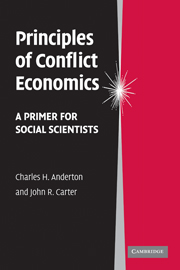Book contents
- Frontmatter
- Contents
- List of Figures
- List of Tables
- Preface
- 1 Introduction: Definition and Scope of Conflict Economics
- 2 Production Possibilities and the Guns versus Butter Trade-Off
- 3 Rational Choice and Equilibrium
- 4 Fundamentals of Game Theory
- 5 A Bargaining Model of Conflict
- 6 Conflict between States
- 7 Civil War and Genocide
- 8 Terrorism
- 9 Geography and Technology of Conflict
- 10 Arms Rivalry, Proliferation, and Arms Control
- 11 Military Alliances
- 12 Conflict Success Functions and the Theory of Appropriation Possibilities
- Appendix A Statistical Methods
- Appendix B A More Formal Bargaining Model of Conflict
- References
- Author Index
- Subject Index
6 - Conflict between States
Published online by Cambridge University Press: 05 June 2012
- Frontmatter
- Contents
- List of Figures
- List of Tables
- Preface
- 1 Introduction: Definition and Scope of Conflict Economics
- 2 Production Possibilities and the Guns versus Butter Trade-Off
- 3 Rational Choice and Equilibrium
- 4 Fundamentals of Game Theory
- 5 A Bargaining Model of Conflict
- 6 Conflict between States
- 7 Civil War and Genocide
- 8 Terrorism
- 9 Geography and Technology of Conflict
- 10 Arms Rivalry, Proliferation, and Arms Control
- 11 Military Alliances
- 12 Conflict Success Functions and the Theory of Appropriation Possibilities
- Appendix A Statistical Methods
- Appendix B A More Formal Bargaining Model of Conflict
- References
- Author Index
- Subject Index
Summary
For millennia, philosophers and sages have pondered the origins and horrors of war. Despite this long history of inquiry, it is only in the last century that scholars from political science, economics, and other disciplines have attempted to use the quantitative methods of social science to study the causes and effects of war. Building on the early work of Lewis Richardson, Pitirim Sorokin, and Quincy Wright, the social scientific study of war was well established by the mid-1960s around a community of scholars associated with the Correlates of War Project, the Peace Science Society (originally, Peace Research Society), the Journal of Conflict Resolution, and the like. Since then, a wealth of social scientific studies of war has appeared in journals and books across the various disciplines (Singer 2000, Anderton and Carter 2007). In this chapter we focus on armed conflict between states, before we turn to civil war in Chapter 7.
The Conflict Cycle
Conflicts typically pass through phases, as shown by Lund's (1996) life-cycle diagram in Figure 6.1, which plots the level of conflict between parties across time. The conflict in question may be interstate as covered in this chapter, intrastate as in Chapter 7, or extra-state as in Chapter 8. The bell-shaped curve represents the course of a typical conflict as hostility rises and falls over time. The vertical axis marks levels of conflict beginning with durable peace and rising successively to stable peace, unstable peace, crisis, and war.
- Type
- Chapter
- Information
- Principles of Conflict EconomicsA Primer for Social Scientists, pp. 83 - 103Publisher: Cambridge University PressPrint publication year: 2009



